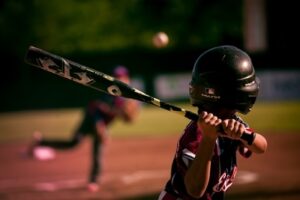Sports and eye safety go hand in hand, or at least they should. The truth is that vision safety isn’t always a priority for most weekend warriors and student-athletes. Fortunately, protective eyewear for sports isn’t hard to come by. What’s more, one of your best resources for sports eye safety tips is your family eye doctor.

To protect your vision no matter the game, we’ll look at:
- Getting a comprehensive eye exam
- Knowing the risks of sports eye injuries
- Choosing the right eye protection
- Being prepared for an accident
- Being an advocate for sports eye safety
Taking sports eye safety seriously won’t just save you a trip to the emergency room. It can actually make you a better player and protect your vision for years to come.
1. Get a Comprehensive Eye Exam
Routine eye exams are what we usually think of when we imagine going to the optometrist. They’re great for people needing to update their eyeglass or contacts prescription, or to see if they need them at all. Think of them as your regular dental checkup, but for your eyes. They’re designed to catch anything that may become a serious problem further down the road.
Our vision can change as we age. We need something more detailed to make sure our eyes are working properly. This is where “medical” or comprehensive eye exams come into play. It’s recommended that adults get a comprehensive eye exam every two years. These exams are much more in-depth and can give insight into how your vision relates to your overall health.
While associated with adults, comprehensive eye exams can also help athletes of all ages to play better. Whether you’re a weekend warrior or the parent of a student-athlete, your family eye doctor can help identify weak spots in your vision and help you develop a plan to overcome them. Not only that, but they can help protect your vision with professional medical advice.
2. Know the Risks of Sports Eye Injuries
According to Prevent Blindness, over 28,000 people needed treatment for sports-related eye injuries in 2018. These sports eye injury statistics remain fairly constant with over 25,000 athletes of different levels requiring treatment for eye injuries every year.
No form of eye protection can protect your eyes 100% of the time while playing sports. However, they can help you avoid common as well as serious eye injuries better than wearing no protection at all.
Sports eye protection can help prevent injuries such as:
- Corneal abrasions
- Hyphema
- Inflamed iris
- Traumatic cataracts
- Fractured eye sockets
- Detached retinas
Eye injuries such as these require immediate medical attention. What’s more, they can lead to other complications with your vision, including vision loss.
It can also help to know which sports present the most danger for eye safety among kids as well as adults. According to a report for 2019, the age groups that experienced the most sports-related eye injury were in the 13-22 and 23+ range. The majority of injuries were due to:
- Basketball
- Pools and watersports
- Non-powder guns, darts, arrows, and slingshots
- Bicycles and accessories
Athletes and the parents of student-athletes need to know the risks in order to provide the best protection possible. Not only will it bring peace of mind, but it will also ensure years of pursuing your passion for sports!
3. Choose the Right Eye Protection
You’ll need more than a pair of sunglasses from the gas station to protect your eyes while playing sports. Like a good pair of prescription sunglasses, you want something that’s up for the task. This will ensure your sports safety glasses provide the most protection you can get.
One thing that athletic prescription sunglasses and protective eyewear have in common is polycarbonate lenses. These lenses are made of impact-resistant material and are ideal for those who lead an active lifestyle. It also doesn’t hurt that they’re polarized to provide UV protection.
The type of eye protection you choose will depend on your sport, although some can crossover for different activities. Eye guards are ideal for basketball but can also be used in baseball or softball if you don’t have a protective visor for your helmet. They don’t offer as much protection as visor but are certainly better than nothing. Faceguards and visors are also perfect for football.
4. Be Prepared for an Accident
As an athlete or a parent of one, you’re well aware of the dangers sports present to you or your child’s health. You want everyone to be as safe as possible but you’re also aware that this isn’t always the case. That’s why you should be as prepared for an eye injury as you are for any other type of accident.
Debris in the Eye
Sometimes you or your child can take a fall and get something in the eye. This could be dust, dirt, grass, or some other kind of foreign object. The first thing to do if this happens is do not rub the eye. This may only serve to grind it into the eyeball and do further damage. You should also avoid using tweezers or similar means to remove the debris.
Instead, give the body a chance to do the work itself by letting tears wash out the debris. If this doesn’t work, use an over-the-counter eyewash from your local drugstore. You can also try lifting the upper eyelid and looking down at the lower eyelid. If none of these work then see your eye doctor immediately.
Cuts and Punctures
It may sound counterintuitive, but do not wash out a punctured eye with any liquid if a cut or puncture occurs, including water. You should also leave the object that’s stuck in the eye. Instead, cover the eye with something sturdy like the bottom half of a paper cup. Hold it gently against the area surrounding the eye until you can get medical attention.
Hits to the Eye
If you or someone else gets hit in the eye, the best thing to do is to apply a cold compress without adding pressure. Seek medical attention immediately if you notice:
- Blurry vision
- Blood in the eye
- Discoloration
- The eye is bulging out more than normal
These all may point to internal eye damage. It’s important to seek medical attention in order to treat the affected eye and prevent any further complications.
5. Be an Advocate for Sports Eye Safety
One of the best things you can do to prevent sports-related eye injuries is to raise awareness about the problem. Whether it’s your group of friends or your child’s sports team, talking about eye safety can help other people understand the risks they face by not taking it seriously.
You can be an advocate for sports eye safety by:
- Practicing eye safety yourself and modeling it for others
- Telling others about how comprehensive eye exams help to play better
- Avoid sports that don’t have adequate eye protection, such as boxing
- Talk with your team about what to do in case of an eye injury
By advocating for sports eye safety, you’ll be protecting your vision as well as the vision of those you care about.
Hardin Valley Eyecare & Optical has been serving Knoxville since 2009. Located at 10904 Spring Bluff Way, you can schedule an appointment online or give us a call at (865) 888-0892.





